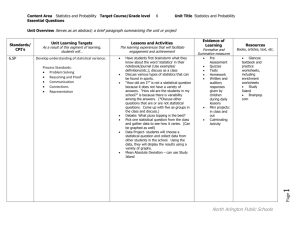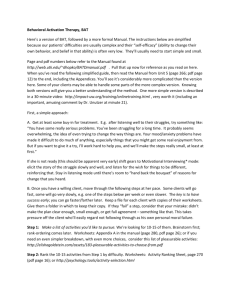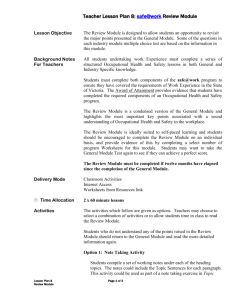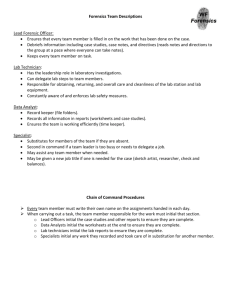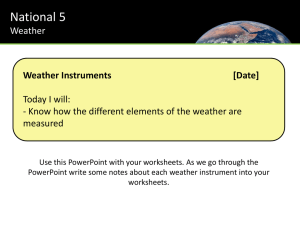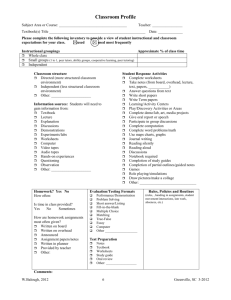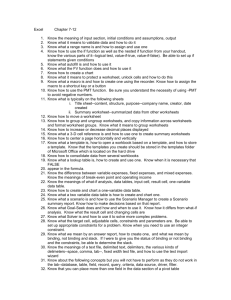Genetics Unit Plan - Tri-Village Local School District
advertisement
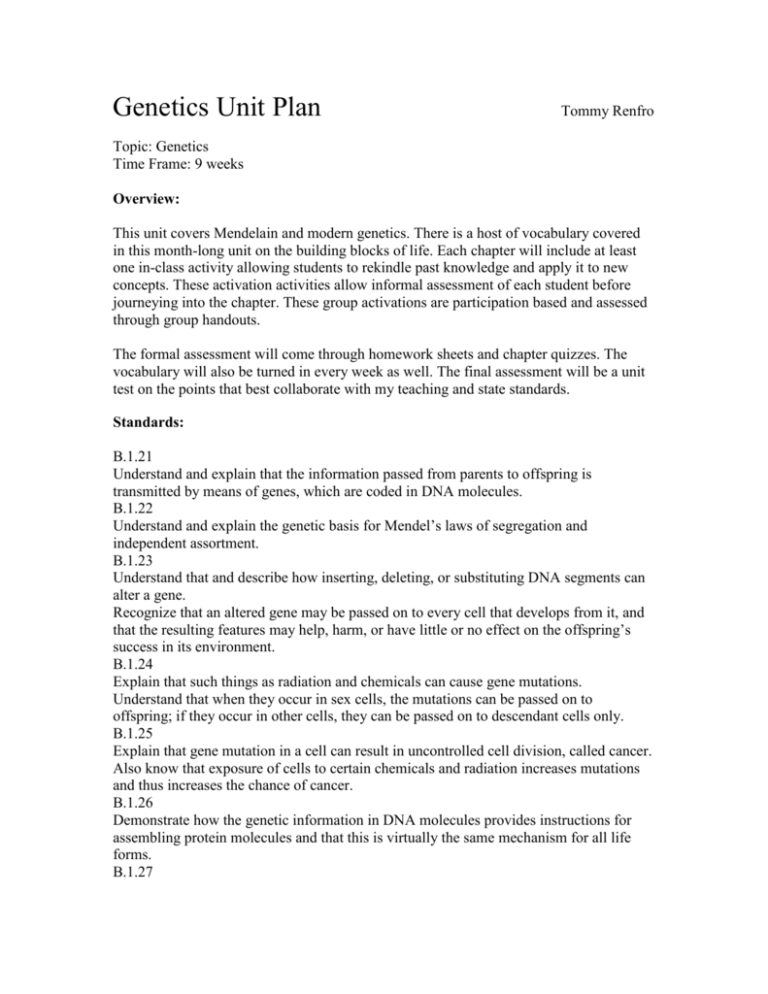
Genetics Unit Plan Tommy Renfro Topic: Genetics Time Frame: 9 weeks Overview: This unit covers Mendelain and modern genetics. There is a host of vocabulary covered in this month-long unit on the building blocks of life. Each chapter will include at least one in-class activity allowing students to rekindle past knowledge and apply it to new concepts. These activation activities allow informal assessment of each student before journeying into the chapter. These group activations are participation based and assessed through group handouts. The formal assessment will come through homework sheets and chapter quizzes. The vocabulary will also be turned in every week as well. The final assessment will be a unit test on the points that best collaborate with my teaching and state standards. Standards: B.1.21 Understand and explain that the information passed from parents to offspring is transmitted by means of genes, which are coded in DNA molecules. B.1.22 Understand and explain the genetic basis for Mendel’s laws of segregation and independent assortment. B.1.23 Understand that and describe how inserting, deleting, or substituting DNA segments can alter a gene. Recognize that an altered gene may be passed on to every cell that develops from it, and that the resulting features may help, harm, or have little or no effect on the offspring’s success in its environment. B.1.24 Explain that such things as radiation and chemicals can cause gene mutations. Understand that when they occur in sex cells, the mutations can be passed on to offspring; if they occur in other cells, they can be passed on to descendant cells only. B.1.25 Explain that gene mutation in a cell can result in uncontrolled cell division, called cancer. Also know that exposure of cells to certain chemicals and radiation increases mutations and thus increases the chance of cancer. B.1.26 Demonstrate how the genetic information in DNA molecules provides instructions for assembling protein molecules and that this is virtually the same mechanism for all life forms. B.1.27 Explain that the similarity of human DNA sequences and the resulting similarity in cell chemistry and anatomy identify human beings as a unique species, different from all others. Likewise, understand that every other species has its own characteristic DNA sequence. B.1.28 Illustrate that the sorting and recombination of genes in sexual reproduction results in a great variety of possible gene combinations from the offspring of any two parents. Recognize that genetic variation can occur from such processes as crossing over, jumping genes, and deletion and duplication of genes. B.1.29 Understand that and explain how the actions of genes, patterns of inheritance, and the reproduction of cells and organisms account for the continuity of life, and give examples of how inherited characteristics can be observed at molecular and whole-organism levels – in structure, chemistry, or behavior. The Nature of Science and Technology It is the union of science and technology that forms the scientific endeavor and that makes it so successful. Although each of these human enterprises has a character and history of its own, each is dependent on and reinforces the other. This first theme draws portraits of science and technology that emphasize their roles in the scientific endeavor and reveal some of the similarities and connections between them. In order for students to truly understand the nature of science and technology, they must model the process of scientific investigation through inquiries, fieldwork, lab work, etc. Through these experiences, students will practice designing investigations and experiments, making observations, and formulating theories based on evidence. Scientific Thinking There are certain thinking skills associated with science, mathematics, and technology that young people need to develop during their school years. These are mostly, but not exclusively, mathematical and logical skills that are essential tools for both formal and informal learning and for a lifetime of participation in society as a whole. Good communication is also essential in order to both receive and disseminate information and to understand others’ ideas as well as have one’s own ideas understood. Writing, in the form of journals, essays, lab reports, procedural summaries, etc., should be an integral component of students’ experiences in Biology I. Unit Objectives: 1. Students will understand that reproductive cells, which pass on genetic traits from the parents to the child, are produced by the process of meiosis 2. Students will understand that human heredity is complex and does not always follow Mendel’s laws. 3. Students will understand that DNA is the building block of life that contains a code for proteins. 4. Students will understand the importance of genetic technology in the advancement of human health and quality of life. Chapter 10 - Sexual Reproduction and Genetics Dec 3 – Launch Lab – Observing phases of mitosis under the microscope Complete lab protocol for 10 points Pass out worksheets for chapter 10 List weekly assignments on board Dec 5 – Lecture Sec. 10.1 – Meiotic development Standards: B.1. 21 Work on section 10.1 worksheet Begin Reading 10.2 Dec 9 – Lecture Sec. 10.2 – Mendelian Genetics Standards: B.1.22 / Depth of inquiry Oompah Loompah Lab (30 min) Complete lab protocol for 10 points Work on section 10.2 / 10.3 worksheets Begin reading 10.3 Dec 11 – Lecture Sec. 10.3 – Gene Linkage and Polyploidy Standards: B.1.28 Turn in worksheets (15 points) Pass out chapter 10 study guide Prepare for chapter quiz Dec 13 – Chapter 10 quiz – Sexual Reproduction and Genetics Give students 10 min. to review Turn in Vocabulary Squares (15 points) Give quiz (50 points) Total Points = 100 Chapter 11 – Complex Inheritance and Human Heredity Dec 17 –Launch Lab- What am I? – This lab gives the students a sheet with the words tongue roller, finger hair, earlobes, taster, etc… Students will complete this lab in about 30 min. The class results will be placed on the white board for lecture and discussion. The completed lab sheet will be turned in for 10 points. List weekly assignments on board Pass out worksheets for chapter 11 Pass out overview of extra credit project Dec 19 –Lecture Sec. 11.1 – Patterns of Human Inheritance Standards: B.1.29 / Nature of Sci and Tech. Work on sec. 10.1 worksheet Begin reading 10.2 Jan 6 –Lecture Sec. 11.2 –Complex Inheritance Standards: B.1.24 Work on sec. 10.2/10.3 worksheets Begin reading 10.3 Jan 8 – Lecture Sec. 11.3-Chromosomes and Human Heredity Standards: B.1.24 Turn in worksheets (15 points) Pass out chapter 11 study guide Prepare for chapter 11 quiz Jan 10- Chapter 11 quiz- Complex Inheritance and Human Heredity Give students 10 min. to review Turn in Vocabulary squares (15 points) Give quiz (50 points) Total Points = 90 MID TERM REVIEW and TEST January 13 – January 16 Co-Teach with Mr. Schlamb Chapter 12-Molecular Genetics (Mr. Schlamb full time) Jan 21 –Launch Lab –History, Hieroglyphics, and DNA. This lab is designed to demonstrate the high level of work that Watson and Crick endeavored in the pursuit of cracking the genetic code. Each student will be given a lab prompt and a blank sheet of paper. Filling out the lab prompt will result in a participation score of 10 points. List weekly assignments on board Pass out worksheets for chapter 12 Class discussion of previous knowledge Jan 23 -Lecture sec. 12.1/12.2 – History and Replication Standards: B.1.21, B.1.27 Work on sec. 12.1/12.2 worksheets Begin reading 12.2/12.2 Jan 27 -Lecture sec. 12.3 – Central Dogma of Biology Standards: B.1.23, B.1.26 Work on Sec. 12.3/ 12.4 worksheets Begin reading 12.3/12.4 Jan 29 -Lecture 12.4 – Gene Regulation and Mutation Standard: B.1. 25 Turn in worksheets (15 points) Pass out chapter 12 study guide Prepare for chapter 12 qui Jan 31 -Chapter 12 quiz – Molecular Genetics Give students 10 min. to review Turn in vocabulary squares (15 points) Give quiz (50) points Total Points = 90 Chapter 13 – Genetics and Biotechnology Monday-Launch Lab-Biological writing. Students will choose two of three prompts to help them dive into section 13.1. These prompts involve using vocabulary and application to prompt higher-level scientific thinking and real-world experiences. Turn in writings for 10 points. List weekly assignments Pass out worksheets for chapter 13 Begin reading chapter 13 Tuesday-Lecture Sec. 13.1 –Applied Genetics Standards: This chapter is above the Biology1 standards. The ideas and concepts are higher-level issues dealt with at the collegiate level. I am using this as a brief introduction to biotechnology and a buffer between the Unit and the Unit Exam. Work on Sec. 13.1 worksheet Continue reading chapter 13 Wednesday- Lecture Sec. 13.2 – DNA technology Finish worksheets Pass out Unit 3 study guide Discuss Extra Credit Projects Thursday – Exam Review and Project Presentations Project Presentations (50 points today)(25 w/o presentation) Jeopardy Review Game Family Feud Review Game Questions for the teacher about exam Worksheets Due (15 points) Friday- UNIT 3 EXAM – Genetics Turn in Vocabulary squares (15 points) 10 Min. of quiet review Unit 3 Exam (150 points) Party as a reward for achieving 85% or higher on all quizzes. Total Points = 190 + bonus * Assessment: My assessments are structured and my routine is consistent. Consistency is key to student understanding. As I began my M401 experience I realized that chaos accomplishes nothing in the classroom. Students have to understand what is expected out of them in advance. This is the only way to build respect! Worksheets Vocabulary Quizzes Exam Bonus with presentation Bonus without presentation (15 x 4) = 60 points (15 x 4) = 60 points (3 x 50) = 150 points (1 x 150) = 150 points Unit Total = 420 points (1 x 50) = +50 points (1 x 25) = +25 points MAX POINTS = 470 / 420 Worksheets – Students will use the worksheets as practice tools to follow as they read each section. These practice tools will help students write down the material they read in a constructive way. Vocabulary – Rather than assign the typical, read and write, vocabulary assignments, I have devised a method of vocabulary called vocab squares. These squares help students to apply the vocabulary by definition, sentence relation, and visual image reflection. Through these students will understand the vocabulary in different learning styles. Quizzes – The quizzes will be written by myself and will cover material discussed in lecture and on lab assignments. Nothing on the quizzes will be from canned material. Students will understand concepts taught by me and be able to apply them through multiple-choice, short answer, and essay formats. Tests – The Unit test will be the culminating assessment of the unit objectives. Students will be able to apply content from chapters 10 through 13 to real-world and simulated experiences. This assessment is a depiction of my ability to facilitate material and the students’ ability to retain content.

